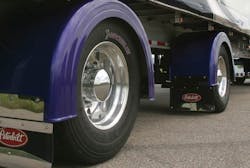Often overlooked and under-appreciated, trailer tires contribute a great deal to a tractor-trailer’s performance. They play a major role in a rig’s overall rolling resistance. And if a trailer tire springs a leak, it can have a detrimental effect on a rig’s basic movement.
As trucking fleets continue to squeeze every penny out of their operating budgets, improving fuel economy and eliminating downtime remain leading trailer tire concerns, according to tire manufacturers.
Resistance now reduced
Reducing a tractor-trailer’s overall rolling resistance is a major goal for most fleets, says Bill Hoban, national truck tire sales manager for Cooper Tire & Rubber Co. And the message is getting out to dealers, he adds.
“I had a dealer call me today and ask what our rolling resistance numbers are. We’re looking at compounding and casing construction” to achieve lower rolling resistance.
Along those lines, Hoban says Cooper is pursuing SmartWay certification from the United States Environmental Protection Agency, which may extend the certification to medium truck tire retreads (see sidebar).
“Trailer tires have been somewhat of a commodity item,” says Roger Stansbie, director of tire technology, Commercial Vehicle Tires, the Americas, for Continental Tire North America Inc.
“From our observation, trailer tire manufacturers tend to choose fairly economical compounds.”
To lower rolling resistance, “you have to start doing more engineering, especially when it comes to compounding,” says Stansbie. “Another method is to really concentrate on your tread designs.”
[PAGEBREAK]
Attention seekers
“The biggest trend we see right now is everyone going green and trying to reduce rolling resistance,” says Rick Phillips, manager of commercial sales for Yokohama Tire Corp.
Yokohama is developing a trailer tire for its eco-friendly Z.environment line, which currently only includes steer and drive axle tires. “Probably within the next year or two you’ll see it on the market.”
Trailer tires require as much attention as steer and drive tires, but don’t often receive it, he explains.
“If you think about all 18 wheel positions on a rig, the driver gets immediate feedback from the steer and drive tires. The trailer is a separate vehicle. Trailer tires take more abuse and are more liable to experience en route failure than any other position.
“Also, a trailer tire may go from carrying 40% of the gross vehicle weight of the truck, then come home empty, carrying hardly any weight.”
Efforts are underway to lighten trailer tires, which, in turn, will lighten the overall weight of the vehicle, says Guy Walenga, director of engineering for commercial products and technologies, Bridgestone Americas Tire Operations LLC.
“Trailer tires are a place where you will see attempts made (to reduce weight).”
Sealed and delivered
While fuel efficiency is a top fleet concern, Larry Tucker, marketing manager, long-haul tires, Goodyear Tire & Rubber Co., says the threat of downtime also remains a big problem, especially since overall freight movement is low.
To help in this arena, Goodyear recently put its DuraSeal self-sealing technology in its G395 LHS Fuel Max truck tire, the first time the company has built DuraSeal into a long-haul product. (Previously, DuraSeal was reserved for short-haul tires.)
Goodyear’s decision to put DuraSeal in the G395 LHS was in direct response to fleet demands, he says.
“We do a fleet symposium twice a year with unsold customers. We pick their brains as to what keeps them awake at night. We found the number one issue was trailer tire flats. That’s what gives them the biggest headaches.”
The long-haul fleet owners surveyed by Goodyear had never heard of DuraSeal, according to Tucker. “They said ‘If you can put it in trailer tires, it would help us so much.’” ■
[PAGEBREAK]SmartWay-approved retreads? -- TRMG gets the ball rolling
A number of new truck tires from Goodyear Tire & Rubber Co., Michelin North America Inc., Bridgestone Bandag Tire Solutions, Continental Tire North America Inc., and Hankook Tire America Corp. have earned SmartWay certification from the U.S. Environmental Protection Agency (EPA).
The Tread Rubber & Tire Repair Materials Manufacturers’ Group (TRMG) has asked the EPA to bring truck tire retreads into the SmartWay program. “To be a SmartWay-approved retread, the retread must be on a SmartWay-approved casing and it must (have) a fuel-efficient tread,” says Larry Tucker, marketing manager, long-haul tires, for Goodyear.
“The EPA has to be able to quantify the value of the retread in terms of rolling resistance,” says Guy Walenga, director of engineering for commercial products and technologies, Bridgestone Americas Tire Operations LLC. “There’s been a lot of work on (developing) fuel-efficient caps.”



